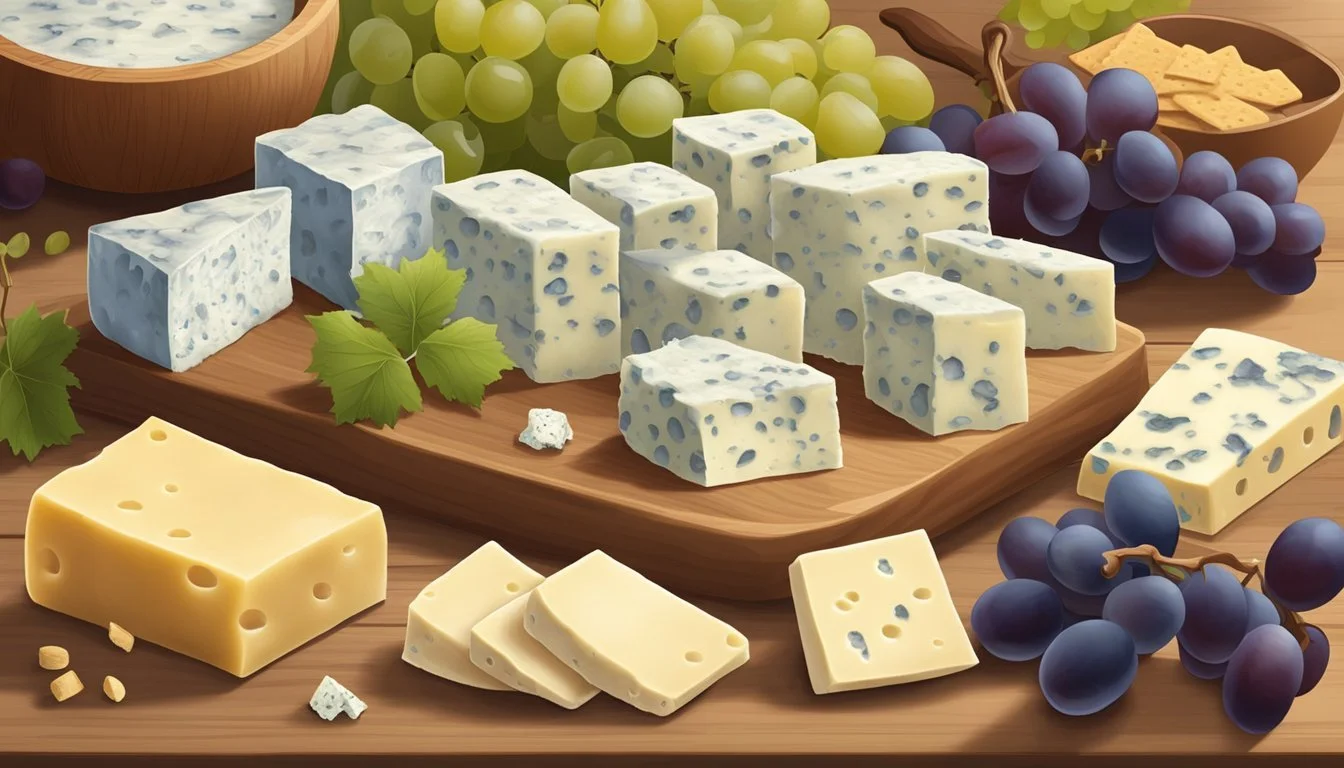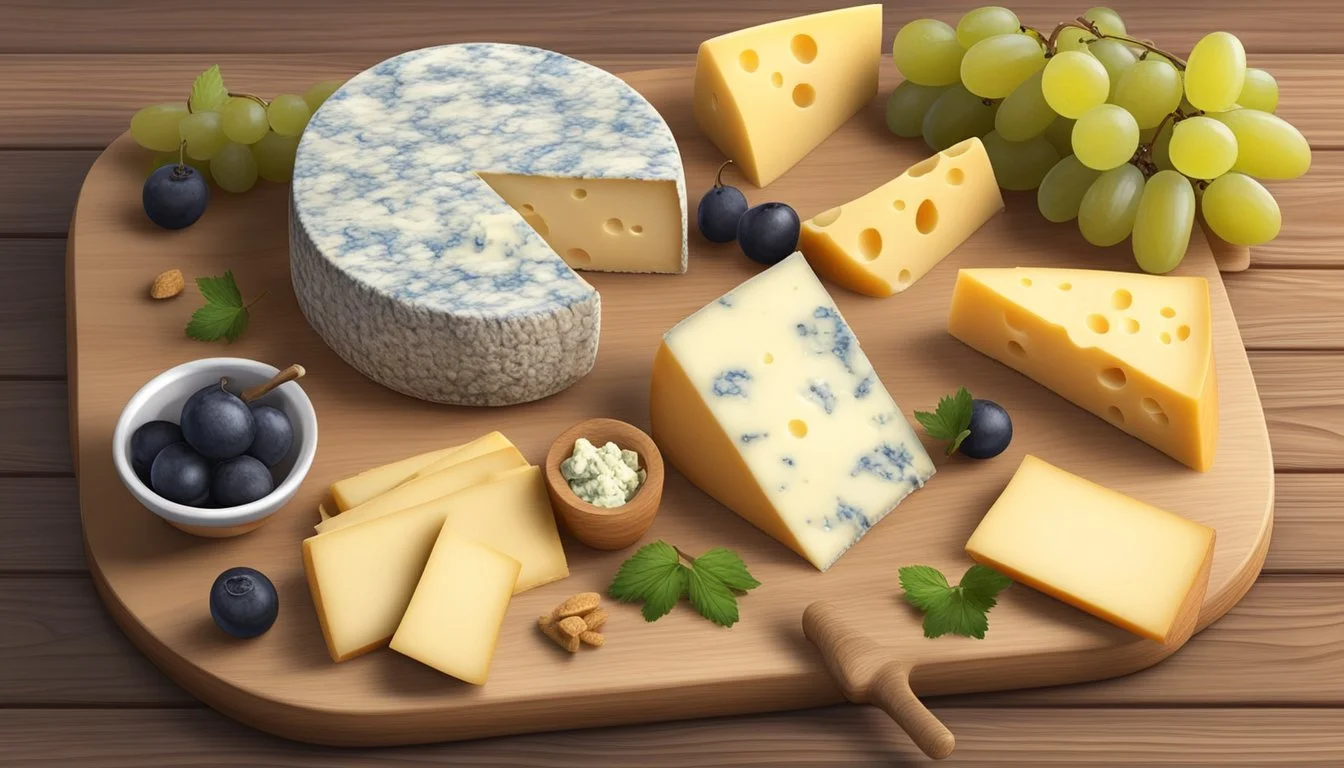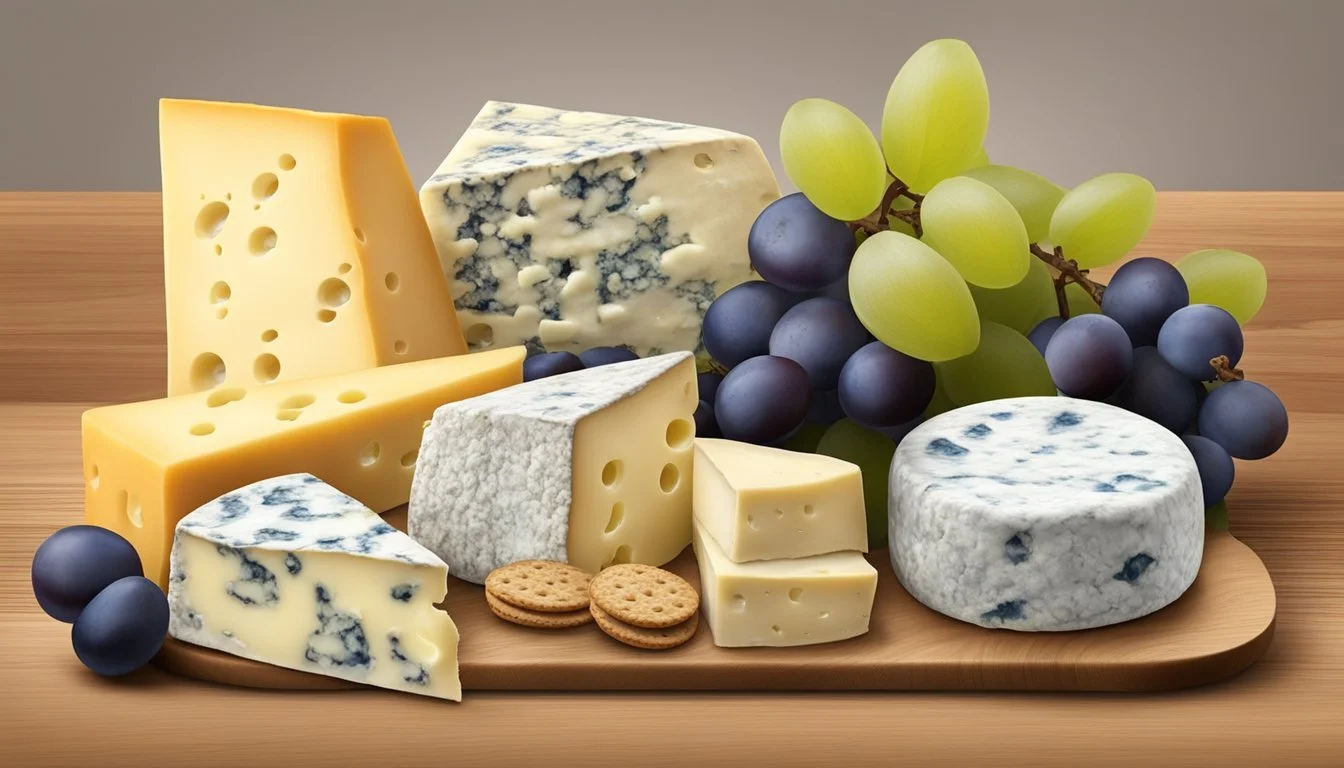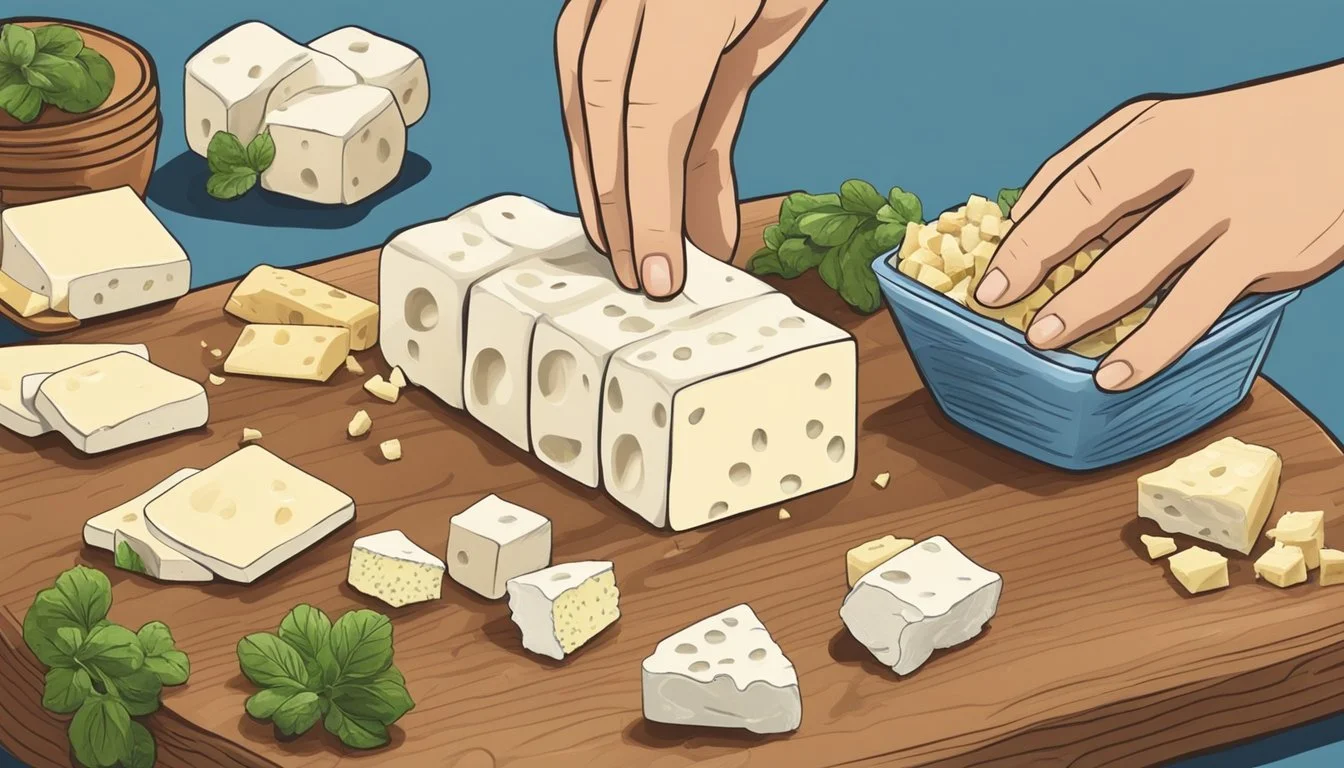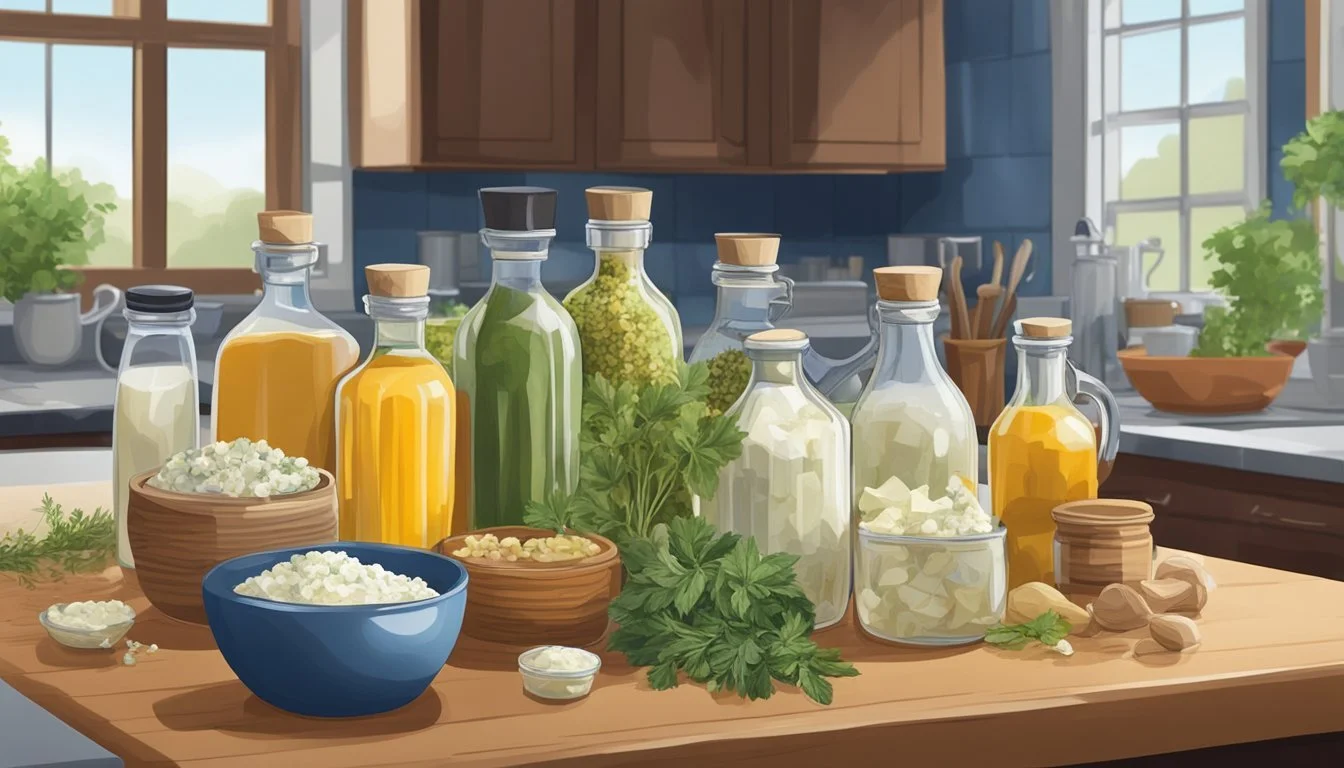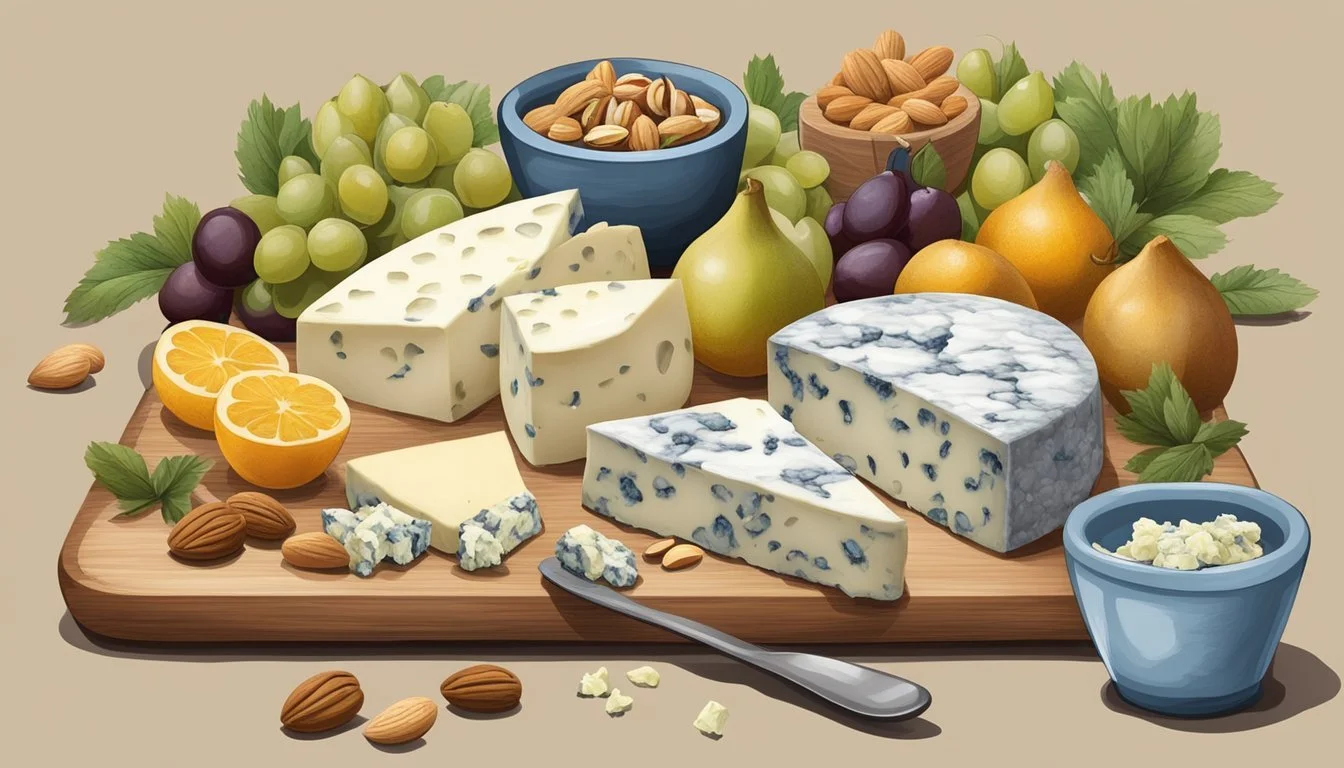Blue Cheese Substitutes
Top Alternatives for Your Recipes
When it comes to culinary versatility, blue cheese (What wine goes well with cheese?) is a standout ingredient known for its unique flavor profile and texture. It's a cheese that can elevate various dishes from salads (What wine goes well with salads?) to sauces with its bold, tangy essence. Blue cheese, characterized by the presence of blue or green mold veins that impart a distinctive sharpness, is a category that includes varieties such as Gorgonzola, Roquefort, and Stilton.
However, not everyone favors the intense taste of blue cheese, or sometimes it's simply out of reach in the kitchen. Fortunately, a range of substitutes offers comparable qualities to blue cheese, each bringing its own set of flavors and textures that can mimic or complement the original ingredient. Substitutes like feta, goat cheese, and aged cheddar are widely suggested due to their similar crumbly nature and ability to blend well with other components in a dish.
Understanding the properties of blue cheese helps in selecting the best alternative for a given recipe. Factors such as moisture content, fat level, and the desired tanginess should guide the choice of a substitute. Whether it's for a blue cheese dressing, a garnish over a steak, or a crumble in a pear salad, knowing the optimal replacements ensures that the dish maintains its intended character and appeal.
Understanding Blue Cheese
Blue cheese is known for its distinctive blue or blue-green veins of Penicillium mold, which contribute to its characteristic flavor and aroma. This cheese varies from creamy and soft to crumbly and sharp, and typically possesses a salty, tangy flavor profile.
Key varieties of blue cheese include:
Roquefort: Hailing from France, it is made from sheep's milk. Roquefort is often sought after for its rich history and earthy, deep flavors.
Gorgonzola: An Italian cheese that comes in two main types:
Gorgonzola Dolce: Aged for a shorter period, resulting in a buttery, sweet flavor and soft, creamy texture.
Gorgonzola Piccante: Known for a strong, spicy flavor and a more crumbly texture, due to longer aging.
Blue cheese's texture is largely influenced by the aging process and the type of milk used. Beyond its culinary uses, the cheese contains a significant amount of protein, fat, and calcium. Additionally, it offers health benefits due to its probiotics content, which can aid in digestion.
The aging process crucially affects both the flavor intensity and texture. Cheese with less aging time will generally be smoother and milder. As it ages, it becomes more pronounced in flavor with a firmer, more crumbly texture.
A final defining characteristic of blue cheese is its pungent aroma, which can be attributed to both the Penicillium mold and the fermentation process. Despite its strong scent and bold flavors, blue cheese is a delicacy enjoyed in many cultures and can elevate a wide range of dishes.
Cheese Characteristics
Choosing a substitute for blue cheese requires understanding the key attributes of flavor, texture, and visual appeal. These characteristics influence the suitability of a replacement in recipes and palates accustomed to traditional blue cheese.
Flavor Profiles
Blue cheese is known for its sharp, pungent, and earthy flavor with a tangy finish. When considering alternatives, one must account for these taste dimensions. Gorgonzola, for example, offers a similar richness and is also laced with blue veins of mold. It can range from buttery sweet (Gorgonzola dolce) to a stronger, more spicy flavor in its piccante form. Roquefort, with its salty and earthy undertones, is made from sheep's milk, offering a different but analogous depth of taste.
Textural Differences
Texture plays a pivotal role in both taste perception and culinary application. Blue cheese typically presents a creamy to crumbly texture spectrum.
Creamy: Younger blue cheeses, like Gorgonzola dolce, boast a soft, creamy texture that easily spreads and melts.
Crumbly: Cheeses aged longer, such as Gorgonzola piccante or Roquefort, have a more crumbly and firm profile which holds up well in salads and as a garnish.
Visual Appearances
The distinctive blue veins running through blue cheese offer not only a unique flavor but also an unmistakable visual hallmark. Substitutes must visually mimic this feature to be convincing alternatives. Feta, although lacking blue veins, provides a crumbly appearance that can visually pass for blue cheese when needed, especially in dishes where the cheese is not the central aesthetic element.
Culinary Applications
In this section, readers will explore how blue cheese and its substitutes can enhance a variety of dishes, from classic salads to gourmet cheese boards.
Dishes Featuring Blue Cheese
Blue cheese is renowned for its bold flavor profile, making it a staple in various dishes. Its robust taste and creamy texture can transform a simple salad into a decadent meal. For instance, a wedge salad with blue cheese dressing becomes an eloquent statement of flavors.
In pasta dishes, blue cheese offers an instant creamy sauce when melted over warm noodles. A classic example is Gorgonzola with pear and walnut pasta. When using substitutes in a pasta dish, Feta or aged cheddar can provide similar richness with less intensity.
The potent flavor of blue cheese is ideal in dips and sauces, mingling beautifully with other ingredients like hot sauce for a buffalo blue cheese dip. Substitutes like queso fresco can be used to achieve a milder, but still tangy, profile suitable for party dips or dressings.
Serving Blue Cheese on Cheese Boards
Blue cheese adds sophistication to cheese boards, pairing well with fruits, nuts, and various crackers or breads. However, its pungent odor and strong taste might not appeal to all. Substitutes such as Roquefort, though still a blue cheese, offer a slightly different taste due to its sheep's milk origin and can cater to those looking for variety.
For an even less intense flavor, a milder cheese like feta or goat cheese can be sprinkled over honeyed pears or figs. These cheeses blend well with fruits and nuts, complementing rather than overpowering the ensemble on a cheese board.
Choosing a Substitute for Blue Cheese
When selecting a substitute for blue cheese, the primary considerations include aligning the flavor profile and texture to suit the intended dish, while also accounting for personal taste preferences and dietary restrictions.
Factors to Consider
Before one chooses a blue cheese substitute, it is important to consider several factors:
Flavor: Blue cheese is known for its distinct sharp, tangy flavor. A good substitute should offer a similar level of intensity without overpowering other ingredients.
Texture: Blue cheeses can range from soft and creamy to crumbly and firm. Matching the texture is key to achieving the desired consistency in recipes.
Saltiness: The salty flavor inherent to blue cheese is often pivotal to the dish it complements. Look for a cheese with a comparable salt profile.
Common Substitutes
The following cheeses are commonly used as substitutes for blue cheese, each bringing a unique combination of flavor and texture:
Gorgonzola:
Flavor: Varies from mild to sharp
Texture: Soft and creamy or firm and crumbly
Use when: Looking for a similar blue cheese experience with slightly different nuances
Roquefort:
Flavor: Strong and pungent with a tangy finish
Texture: Crumbly and moist
Use when: A robust cheese presence is desired, and the dish can handle a more assertive profile
Feta:
Flavor: Mild and tangy, less intense than most blue cheeses
Texture: Crumbly and somewhat creamy
Use when: A subtle cheese backdrop is needed, preferably in cold dishes like salads
Other cheeses that can act as blue cheese substitutes include aged cheddar for its sharpness, goat cheese for its tang, or queso fresco for a milder flavor and softer texture. Choosing the right substitute for blue cheese depends on the dish and the desired sensory attributes, whether one prioritizes flavor or texture, or seeks a balance of both. Each substitute offers a unique twist on the classic blue cheese profile and should be chosen according to the specific needs of the recipe and the preferences of the consumer.
Popular Blue Cheese Substitutes
When seeking alternatives to blue cheese, it's essential to consider the type of milk used and whether a dairy-free option is needed. A variety of cow's, sheep's, and goat's milk cheeses, alongside non-dairy substitutes, offers diverse flavors and textures to match the distinct taste of blue cheese.
Cow's Milk Cheeses
Gorgonzola, specifically the milder Gorgonzola Dolce, is a superb stand-in for blue cheese. Originating from Italy, this cow's milk cheese is known for its creamy texture and sweet, buttery flavor when young, but becomes more robust and spicy with age, similar to Gorgonzola Piccante. Cheddar, particularly sharp and firm varieties, can mimic the strong taste of blue cheeses, like Stilton. Danish Blue and Cambozola, a German cheese that combines the creaminess of Camembert with the sharpness of Gorgonzola, are also suitable replacements.
Gorgonzola Dolce: Creamy, sweet flavor
Gorgonzola Piccante: Strong, spicy flavor
Sharp Cheddar: Provides a strong taste
Danish Blue: Tangy, close to blue cheese flavor
Cambozola: Creamy with a blue cheese bite
Sheep's Milk and Goat's Milk Cheeses
Roquefort cheese, with its rich and tangy profile, is an iconic substitute made from sheep's milk. It carries a similar intense flavor as traditional blue cheese. Feta, typically made from sheep or goat milk, is a Greek cheese that offers a crumbly texture and a tangy kick, albeit milder than most blue varieties. Monte Enebro, a goat cheese from Spain, can stand in for blue cheese in recipes requiring a creamy yet potent character.
Roquefort: Strong, salty flavor; sheep's milk
Feta Cheese: Milder tangy flavor; sheep or goat
Monte Enebro: Potent, creamy; goat's milk
Non-Dairy and Vegan Alternatives
For those who eschew dairy products, vegan blue cheese options are gaining popularity. These alternatives are typically made from base ingredients like nuts or soy and are cultured to deliver a flavor close to that of traditional blue cheese. Vegan cheeses often incorporate elements such as miso or nutritional yeast to achieve the requisite sharpness and depth.
Vegan Blue Cheese: Cultured from nuts or soy; mimics blue cheese flavor
In choosing a substitute for blue cheese, the context of the dish and personal taste preferences should guide the selection. Each of these cheeses carries its own unique characteristics that can enhance various recipes that traditionally call for blue cheese.
Condiments and Additives to Mimic Blue Cheese
In seeking a plant-based substitution for blue cheese, one must consider the unique flavor profile: salty, tangy, sharp, and creamy. The goal is to replicate the strong flavor and creamy texture associated with traditional blue cheese, using various condiments and additives.
Creating Cheese Flavors
To create the salty and tangy components typical of blue cheese, certain ingredients can be strategically combined. Cashews, when soaked and processed, form a creamy base that can be enhanced with the following:
Apple cider vinegar or lemon juice: For a sharp, tangy taste
Miso paste: Introduces a salty flavor and contributes to the desired sharpness
Nutritional yeast: Adds a cheese-like flavor and can thicken the consistency
This blend, with the nuttiness of cashews at its foundation, closely approximates the complex flavor profile of blue cheese.
Enhancing Taste in Recipes
When infusing a recipe with the indispensable traits of blue cheese, several ingredients are particularly effective:
Coconut oil: To attain a richer, creamier consistency
Onion powder: To introduce subtle savory notes without overpowering the desired cheese flavor
Salt: To fine-tune the overall salty taste of the dish, an essential aspect of mimicking blue cheese
Recipes may also incorporate olives to add depth to the flavor, playing off the sharpness and saltiness with their briney, savory qualities.
Incorporating Substitutes in Recipes
When incorporating blue cheese substitutes into recipes, one must consider the desired texture and flavor profile. Substitutes can range from mild to intense, and may be softer or more crumbly than blue cheese.
Adjustments for Salads and Dressings
In salads, a blue cheese substitute should complement the other ingredients without overpowering them. Gorgonzola, with its buttery sweet flavor, works well in softer salads that benefit from a creamy texture. For a tangy yet less pungent taste, feta—a Greek cheese—can be crumbled over greens, balancing the salad's flavors.
For dressings, where blue cheese’s unique taste is a star, one may opt for ranch dressing for a milder American twist. To maintain a distinct flavor reminiscent of traditional blue cheese dressing without the strong bite, one can try using Italian Gorgonzola dolce or a mild Danish Blue.
Modifying Pasta and Risotto Dishes
Pasta and risotto often use blue cheese for a rich, deep flavor and creamy consistency. When substituting, consider the saltiness and melting properties of the alternative cheese.
For a creamier texture: Gorgonzola melts well, making it ideal for a smooth sauce in pasta dishes.
For an intense, salty flavor: Spanish blue cheese varieties can be sprinkled into risotto for a flavor similar to traditional blue cheese.
Baking and Cooking with Cheese Substitutes
Substitutes for blue cheese in baking and cooking should have similar melting characteristics and flavor intensity.
For a robust taste: Roquefort, with its salty and tangy profile, mirrors blue cheese in heartier recipes.
For a milder, more versatile cheese: A young Gorgonzola can be incorporated into stuffings or toppings where a softer and less assertive cheese is preferable.
When creating dishes that are traditionally known for their blue cheese flavor, selecting the right substitute is crucial in achieving the desired outcome, both in taste and texture. Each substitute brings its own unique qualities to the culinary experience.
Nutritional Considerations
In the context of blue cheese substitutes, nutritional profiles vary widely, impacting calorie count, macronutrients, and specific dietary restrictions. This section will contrast the nutritional content of various cheeses and examine the broader dietary implications their consumption may have.
Cheese Nutrient Comparison
Different types of cheese offer varying levels of calories, proteins, fats, and calcium. Here is a comparison of nutritional content per 100 grams for common substitute cheeses:
Cheese Type Calories Protein (g) Fat (g) Calcium (mg) Blue Cheese 353 21.4 28.7 528 Gorgonzola 357 21.4 28.7 395 Feta 264 14.2 21.3 493 Goat Cheese 364 22.0 29.8 140 Vegan Cheese (varies) Varies Varies Varies Varies
Blue cheese substitutes, such as Gorgonzola, tend to be similar in their nutritional makeup, offering comparable levels of protein and fat. Conversely, vegan options can significantly differ due to their unique ingredients such as coconut oil, cashews, or soy.
Dietary Implications of Cheese Consumption
Cheese can be a source of essential nutrients, providing benefits through proteins and calcium essential for bone health. Blue cheese and its substitutes generally contain probiotics, beneficial bacteria that support digestive health. However, they may also carry a high caloric count and fat content, making moderation key.
For those with specific dietary considerations:
Lactose intolerance: Options such as lactose-free cheeses or aged cheeses with lower lactose content might be more suitable.
Vegan diet: Vegan cheese avoids animal products, including milk and rennet, but may lack some of the probiotics found in traditional cheeses—unless fortified.
Health restrictions: Low-sodium and low-fat cheeses are available for individuals monitoring their intake due to health conditions.
Understanding these nutritional nuances helps individuals select suitable blue cheese replacements that align with their dietary goals and restrictions.
Global Varieties of Blue Cheese
The array of blue cheeses around the globe reveals an eclectic mix of flavors, textures, and origins. Each variety reflects its cultural backdrop and historical cheesemaking practices.
European Blue Cheeses
Roquefort: Originating from France, Roquefort cheese is made from sheep's milk. It carries the Penicillium Roqueforti mold, which provides the cheese with rich, bold flavors and its notable blue veins. Protected by AOC designation, Roquefort is often regarded as the "King of Cheeses."
Gorgonzola: This Italian cheese comes in two main varieties: Gorgonzola Dolce and Gorgonzola Piccante. Gorgonzola Dolce is the milder and creamier of the two, aged for approximately two months, whereas Gorgonzola Piccante, also known as Gorgonzola Naturale, is aged longer and sports a more pungent and crumbly texture.
Stilton: Known as the quintessential English blue cheese, Stilton is creamy with a distinctive earthy flavor. It is only produced in Derbyshire, Leicestershire, and Nottinghamshire and features a Protected Designation of Origin (PDO) status.
Danablu: Danish Blue cheese, or Danablu, is Denmark's sharp and salty contribution to the blue cheese family. It offers a milder yet robust flavor compared to some of its more intense European counterparts.
Bleu d'Auvergne: Hailing from France, this cheese is less intense than Roquefort, offering a creamy texture and a spicy taste. It is made from cow's milk and is punctuated by the presence of Penicillium Roqueforti.
American Blue Cheeses
Maytag Blue: An American original, Maytag Blue cheese originates from Iowa and is crafted from homogenized cow's milk. Its flavor is tangy and its texture ranges from crumbly to creamy. This cheese has been a staple in the United States since its development in 1941.
Other International Cheeses
While not as globally renowned as some European or American varieties, other countries also produce distinctive blue cheeses that showcase their unique cheese-making traditions and cultural flavors. Each region contributes its signature characteristics to the world's blue cheese tapestry.
Conclusion
When it comes to finding a substitute for blue cheese, several options cater to different tastes and recipe requirements. For those who appreciate a cheese with a rich history and a robust flavor, Roquefort stands out as an alternative, thanks to its sheep's milk origin and notable presence in gourmet cuisine. Gorgonzola offers two varieties: the milder Gorgonzola dolce with a creamy texture and the sharper Gorgonzola piccante, which is more crumbly. Both are made from cow's milk and impart a distinct tanginess similar to blue cheese.
For cooks seeking a milder profile or a cheese lower in calories and fat, goat cheese presents itself as a suitable replacement. It maintains the creamy texture needed in many dishes while providing a tang that echoes blue cheese’s characteristic flavor. Another classic stand-in is Stilton cheese, an English variety known for its strong smell and flavor which are comparable to those of blue cheese, albeit with a crumbly texture that tends not to spread as easily.
Substitute Milk Source Flavor Profile Texture Roquefort Sheep Pungent, distinctive Crumbly, moist Gorgonzola Cow Sweet to spicy Creamy to crumbly Goat Cheese Goat Mild, tangy Creamy Stilton Cow Strong, pungent Crumbly
It's clear that each cheese offers a unique set of characteristics that can be used interchangeably depending on the consumer's preference and the specifics of the recipe they are following. Cheeses such as Roquefort and Stilton maintain the pungent strength needed in more flavor-forward dishes, while goat cheese and Gorgonzola provide versatility for those who prefer a milder or creamier profile. Chefs and home cooks alike have the ability to select the appropriate blue cheese substitute to elevate their culinary creations.

